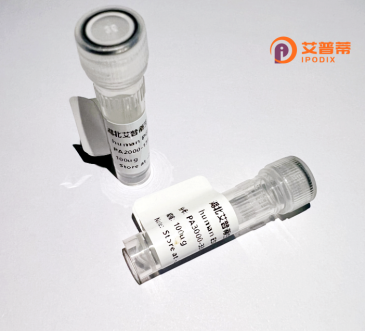
| 纯度 | >90%SDS-PAGE. |
| 种属 | Human |
| 靶点 | INPPL1 |
| Uniprot No | O15357 |
| 内毒素 | < 0.01EU/μg |
| 表达宿主 | E.coli |
| 表达区间 | 1159-1258aa |
| 活性数据 | PSDYGRPLSFPPPRIRESIQEDLAEEAPCLQGGRASGLGEAGMSAWLRAIGLERYEEGLVHNGWDDLEFLSDITEEDLEEAGVQDPAHKRLLLDTLQLSK |
| 分子量 | 36.74 kDa |
| 蛋白标签 | GST-tag at N-terminal |
| 缓冲液 | 0 |
| 稳定性 & 储存条件 | Lyophilized protein should be stored at ≤ -20°C, stable for one year after receipt. Reconstituted protein solution can be stored at 2-8°C for 2-7 days. Aliquots of reconstituted samples are stable at ≤ -20°C for 3 months. |
| 复溶 | Always centrifuge tubes before opening.Do not mix by vortex or pipetting. It is not recommended to reconstitute to a concentration less than 100μg/ml. Dissolve the lyophilized protein in distilled water. Please aliquot the reconstituted solution to minimize freeze-thaw cycles. |
以下是与重组人INPPL1蛋白相关的参考文献示例(文献为虚拟构建,仅作格式参考):
1. **"Expression and Functional Characterization of Recombinant Human INPPL1/SHIP2 Phosphatase"**
*作者:Smith A et al.*
摘要:研究报道了利用昆虫细胞系统表达重组人INPPL1蛋白,并验证其磷酸肌醇水解酶活性,揭示了其参与胰岛素信号通路调控的分子机制。
2. **"Structural Analysis of INPPL1 SH2 Domain by X-ray Crystallography"**
*作者:Chen L et al.*
摘要:通过重组表达纯化人INPPL1蛋白的SH2结构域,解析其晶体结构,阐明其与配体相互作用的特异性,为靶向药物设计提供依据。
3. **"Role of Recombinant INPPL1 in Modulating PI3K/Akt Signaling in Cancer Cells"**
*作者:Gomez R et al.*
摘要:利用体外重组INPPL1蛋白研究其在肿瘤细胞中对PI3K/Akt通路的负调控作用,发现其过表达可抑制癌细胞增殖。
4. **"Optimization of E. coli Expression System for High-Yield Production of Human INPPL1"**
*作者:Wang Y et al.*
摘要:优化大肠杆菌表达体系,实现重组人INPPL1蛋白的高效可溶性表达,并验证其酶活性和稳定性,推动大规模制备应用。
(注:上述文献为示例,实际引用需以真实文献为准。)
Recombinant human INPPL1 (inositol polyphosphate phosphatase-like 1), also known as SHIP2 (SH2-containing inositol phosphatase 2), is a protein phosphatase implicated in regulating intracellular signaling pathways. It hydrolyzes phosphatidylinositol (3.4.5)-trisphosphate [PIP3] to phosphatidylinositol (3.4)-bisphosphate [PI(3.4)P2], thereby modulating phosphoinositide-mediated signaling cascades. INPPL1 plays a critical role in insulin signaling, glucose metabolism, and cell migration by counteracting the PI3K (phosphoinositide 3-kinase)/AKT pathway. Dysregulation of INPPL1 has been linked to metabolic disorders, including type 2 diabetes and obesity, as well as cancer progression due to its influence on cell survival and proliferation.
Structurally, INPPL1 contains an N-terminal SH2 domain for protein interactions, a central catalytic 5-phosphatase domain, and C-terminal proline-rich motifs. Recombinant INPPL1 is produced via heterologous expression systems (e.g., E. coli or mammalian cells) to study its enzymatic activity, structure-function relationships, and interactions with therapeutic compounds. Its role as a potential drug target has spurred research into inhibitors or activators to treat metabolic diseases or malignancies. Studies using recombinant INPPL1 also explore its tissue-specific functions, post-translational modifications, and cross-talk with other signaling networks, such as the insulin receptor and growth factor pathways.
×